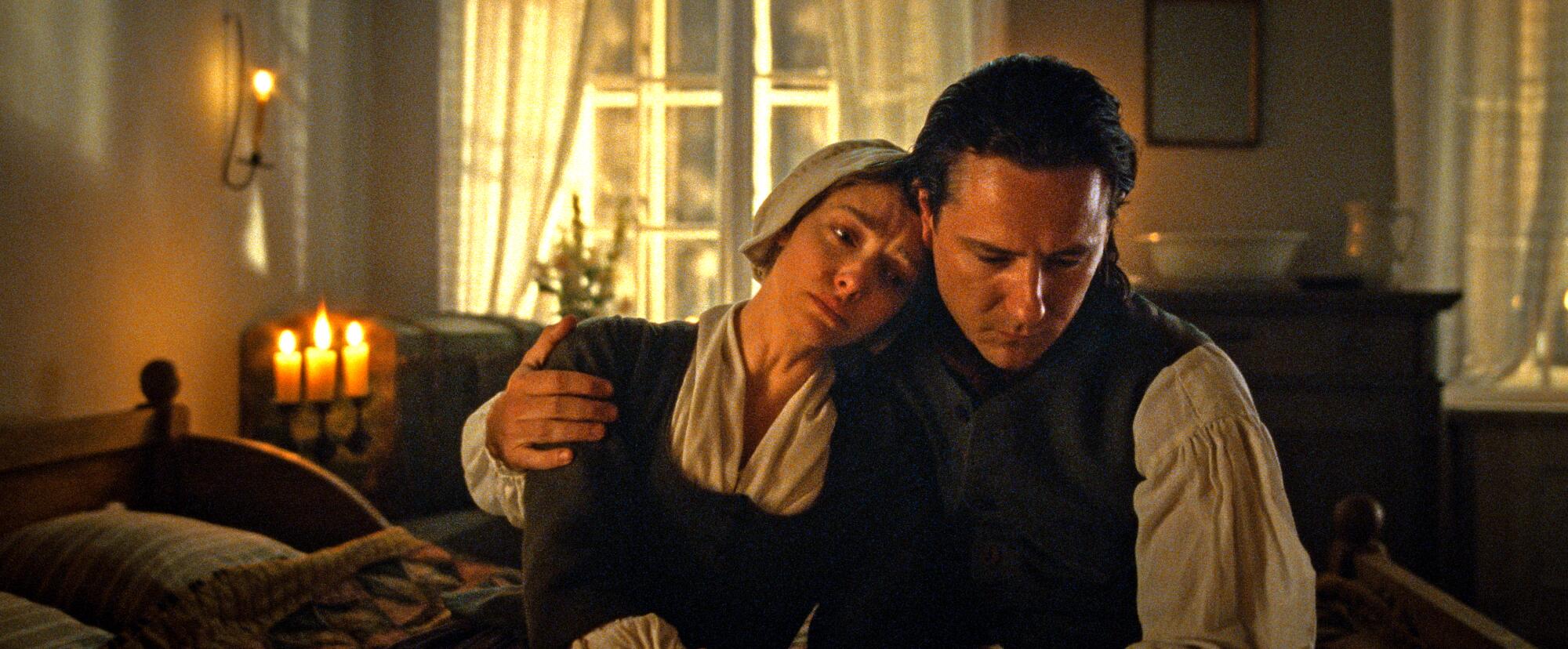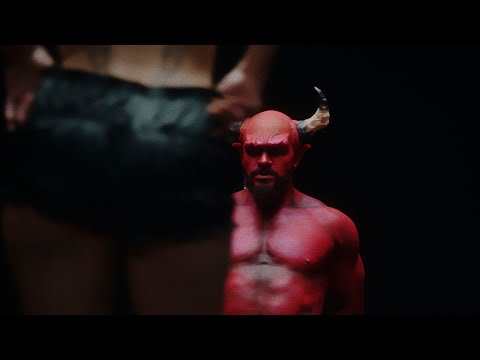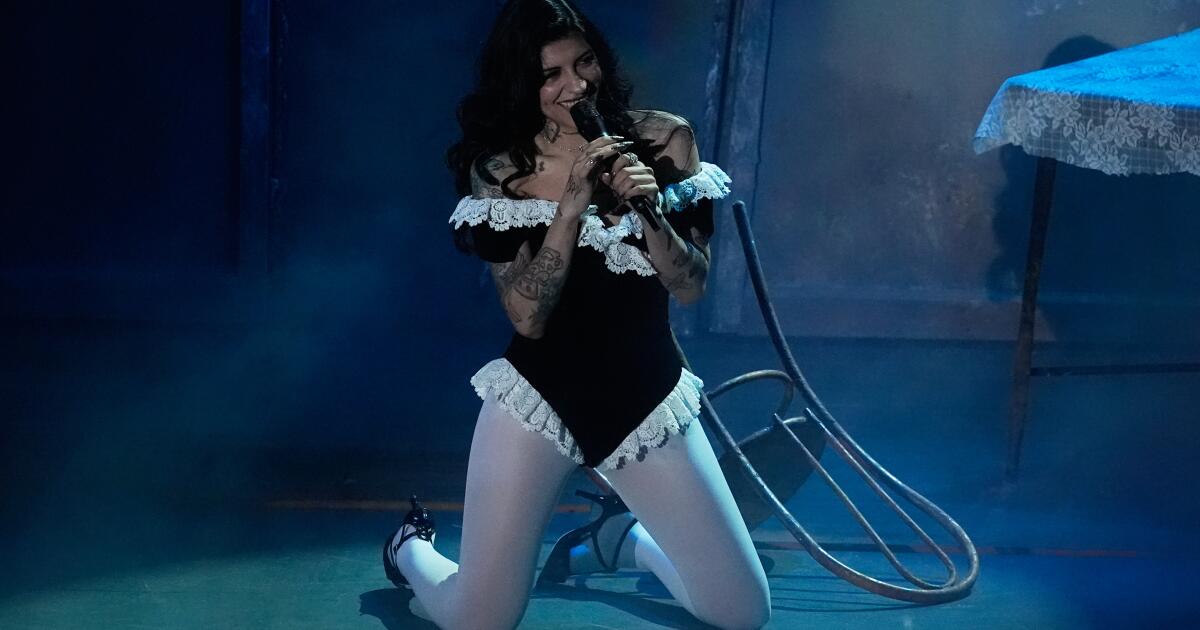Scorer Daniel Blumberg on how he brought ‘The Testament of Ann Lee’ to life
If the Shakers have a lasting cultural legacy, it is their music — most famously “Simple Gifts,” the uplifting spiritual Aaron Copland immortalized in his ballet “Appalachian Spring.” It stands to reason, then, that a film about Ann Lee, the founding “mother” of this 18th century celibate Christian sect, would be a musical. But this was no conventional woman and “The Testament of Ann Lee,” directed by Mona Fastvold and opening in L.A. on Dec. 25, is no ordinary musical.
“Ann Lee was very radical and extreme,” says composer Daniel Blumberg, “and Mona is as well.”
As conceived by Fastvold and Blumberg, the entire tapestry of this film is musicalized — from the emphatic breathing, chest thumping and floor stomping that make up the worshipers’ rituals, to the songs, inspired by Shaker traditionals and performed by star Amanda Seyfried and the cast. Even the sounds of wind, the creaking of ships and a passing cow play a part.
“This cow walks past during the song ‘I Love Mother,’” says Blumberg, 35, visiting L.A. from his native England and speaking from a hotel room over Zoom. Bald with severe features but a soft and guileless disposition, he’s fidgety about the whole Hollywood press dance — this is only his fourth feature film score. But Blumberg is eager to dissect his music-making process and brag about his collaborators. “We were tuning the cows to the song,” he says.

Amanda Seyfried and Lewis Pullman in the movie “The Testament of Ann Lee.”
(Searchlight Pictures)
In a prologue about Lee’s harsh childhood in Manchester, England, her mother hums a tune to her based on the traditional Shaker hymn “Beautiful Treasures.” The melody is then completed on celeste in Blumberg’s score, surrounded by a liturgical choir. The entire film is this kind of holistic musical current: score, songs and environment all in conversation with each other, every component a part of the dance.
“The whole project was very dangerous,” says Blumberg, an indie singer-songwriter with a cult following in the U.K. and now an Oscar for last year’s “The Brutalist.” “It’s always on the edge. And for me that’s a good place to be when you’re making art.”
In one stunning montage, we see a newly married Lee subjugated to religiously-tinged sex (a catalyst for her dogmatic rejection of carnal relations), give birth to several babies, mourn their deaths and express her sorrow in a fervent dance for God. Erotic noises and the cries of childbirth weave together with prayerful moaning and a mother’s keening cries, all integrated into Blumberg’s instrumental score — a guided meditation for bells and strings — with Seyfried singing “Beautiful Treasures.”
“It was very important to me to try and create this hypnotic feel to the film,” says Fastvold, speaking on Zoom from her car during the awards-season whirlwind. “You had to understand it on a sensorial level. Because I think a lot of the appeal, especially early on, were these kinds of endless dance/voice/confession sessions that would last for days.”
“If it’s just someone preaching to you,” she adds, “I certainly can’t connect to that.”
The director, 44, grew up in a secular home in Norway, but her film about this radical American sect is strikingly earnest. Fastvold doesn’t judge Lee’s convictions; there isn’t an ounce of cynicism or condescension. After having a prophetic vision in which Lee is told she is the female incarnation of Jesus Christ, Seyfried sings, “I hunger and thirst / After true righteousness / I hunger and thirst” with utter heart-bleeding sincerity. The camera and the music share her faith completely.
“I never felt like I wanted to laugh at them,” says Fastvold. “I wanted to laugh with them and sometimes their naivete is funny and endearing. But I never wanted to ridicule them. Of course, it’s a very scary thing to try and do.”
When Seyfried read the screenplay two years ago, she experienced some of that intimidation.
“It was definitely the most confused I’ve been in a while reading a script,” she says, nursing a hot tea on Zoom, “because I’m seeing these placeholders for where the hymns will be, when the music comes in, when the diegetic sound goes out or if it doesn’t at all. It was all very foreign to me — which is not necessarily a bad thing. It just leaves me with so many questions.”
Fastvold co-wrote “The Testament of Ann Lee” with her partner, Brady Corbet, who directed “The Brutalist.” They were developing it while working on his breakthrough epic. Blumberg, who has made a number of solo albums and been part of several bands including Cajun Dance Party and Yuck, became friends with Corbet a decade ago. The trio became inseparable.
Fastvold was listening to Blumberg’s records when she decided to direct “The World to Come” in 2020, a warm historical romance about two women in a chilly frontier America. She remembers being captivated by the “beautiful dissonance” in his music. “There’s this mournful, slightly atonal quality to his compositions,” she says.
Fastvold hired Blumberg to score her film — his first — and invited him to the set in Romania to experience the time-traveling feeling of the woods and the sound of passing sheep. She even gave him a small on-screen part, selling a blue dress to Katherine Waterston’s character. It was emblematic of her and Corbet’s then-burgeoning philosophy: of making lavish films on a shoestring, using stunning foreign environments to portray a bygone America and roping crew members and family into the collaboration.
For her ambitious follow-up musical about the Shakers, Fastvold knew she needed Blumberg at the ground level, along with choreographer Celia Rowlson-Hall, a collaboration that required proximity. “We kind of move in together for a while and just start figuring it out,” Fastvold says.

“The whole project was very dangerous,” says Blumberg. “It’s always on the edge. And for me that’s a good place to be when you’re making art.”
(Ian Spanier / For The Times)
They discussed how to cast a spell on the audience and how, with cinema, “you’ve got these tools to use,” says Blumberg, “with image, sound, the writing of it all and just to push those as far as possible. Obviously with the edit you can move in time very quickly, and then with sound you can bring people into the room that the characters are in, but also bring them into the heavens. It was trying to use the materials that we had to make an experience — with the story, but inside the story as well. An immersive experience.”
Fastvold and Blumberg immersed themselves in the thousands of songs the Shakers left behind, including hymns and what the group called “gift songs” and “dance songs.”
“What is our dialogue with this tradition and what is it that we’re bringing to this conversation?” Fastvold remembers them asking each other. “Because really that, to me, is what folk music is. It’s passed on, it’s transformed — it turns into something else and then passed on again.”
They found several Shaker songs that fit the needs of given scenes and moments; whenever they couldn’t, Blumberg wrote an original. The Jewish composer recalled the niguns — wordless, improvised prayers — that he grew up hearing in synagogue, and he drew on that sense memory. Many Shaker songs are mantra-like prayers addressed to God, simple rising and falling melodies based on a short repeated phrase. Blumberg got creative with the harmonies, creating demos that he sang himself.
“It was very nerve-racking,” he says, “because score is a moment where you can fix things — you do it after the edit — but this was going to define the pace of the film. There’s quite high stakes of it working.”
Seyfried was nervous too. Even though she’s a trained singer, with film credits including “Mamma Mia!” and “Les Misérables,” this peculiar religious epic required an enormous leap of faith.
“I knew Mona was going to shoot it beautifully,” Seyfried says, “and I knew that Daniel was going to be there every step of the way. And I knew that I was in good hands — but I didn’t know at that point that I could trust myself as a singer, as a musician. It was completely new territory for me. Terrifying.”
The songs were prerecorded for playback on set. The first thing Seyfried recorded in studio was an a cappella song for a scene late in the film — the lyric is “How can I but love my dear faithful children?” She says she felt miserable.
“I was just like: I sound terrible,” Seyfried says sincerely. “This song is not fun to sing. It’s beautiful, but I don’t sound beautiful. I don’t like the way I sound. And we kept doing it and my voice was dry.”
Blumberg patiently worked at finding the most comfortable key for her voice. “I had no idea how lucky I was,” she says.

Amanda Seyfried in the movie “The Testament of Ann Lee.”
(TIFF)
In the process of working with Blumberg, Seyfried says she came to a deeper appreciation of the character as well as her own singing voice. “I was so critical of it,” she remembers, but the role gave her a different kind of freedom. “I was playing somebody who didn’t necessarily have to be a beautifully trained singer,” she says. “She sang because she wanted to feel alive, and she wanted to feel free, and she wanted to feel connected to her faith — and that already just liberates the performer.”
After extensive rehearsals that continued throughout production, Fastvold shot the film in Budapest. Blumberg was always on set, accompanying the actors with a small keyboard. (Thomasin McKenzie and Lewis Pullman are among the cast members who also sing in the film.) Sometimes the actors had a simple click track in an earpiece, other times a “stomp track” from the foot choreography. They would sing live in addition to lip-syncing to playback and Fastvold amassed a huge variety of live tracks — vocals, breaths and other bodily sounds — for her final mix.
“I wanted all of that life and that natural feel to it,” she says, “to not have it feel polished at all, to just be really raw. Because they weren’t singing to entertain. It’s never performative. It’s always from this place of prayer or pain.”
With her principal cast surrounded by Hungarian extras, Fastvold roped everyone, from the dialect coach to the first assistant director’s son to Blumberg’s sister, into the dance.
“If you came to visit, you were in the movie,” she says. “The cast is the crew and the crew is the cast. It’s how I like to do it.” Once again, Daniel Blumberg appears on-screen, in scenes of Shaker worship; he also sings an original duet, “Clothed by the Sun,” with Seyfried under the end credits.
But at this point his work was only half done. Armed with a cut of the film, pillared by the songs he wrote and arranged, Blumberg crafted a score that subtly teed up song melodies and established a sense of spiritual trance. He gravitated toward the sound of bells; he and Fastvold found a handbell from Ann’s era that they used in early demos and he ended up renting some 50 church bells, in different keys, all laid out on the floor of his London flat.
He extended the bell idea with the jangly celeste, also known as a bell piano, and he augmented those bells with a small string ensemble, a choir and, at one point, even an electric guitar.
It was Blumberg’s idea to have two veteran improvising singers, Phil Menton and Maggie Nichols (who also appears in the film), to each record a track where they improvised along to the entire film. Working with mixer Steve Single, Fastvold and Blumberg would occasionally bring up one of these stems and layer it into the rest of the soundtrack for an added color.
“We’d say, ‘Let’s hear what Maggie was doing at this point,’” Blumberg says, “and then we’d bring up her stem and be like, ‘Oh, wouldn’t it be nice if she follows that character there?’ Or, ‘Wouldn’t it be nice if she’s humming outside the window?’ Or if it’s almost like the heavens speaking down on Ann?”
The final result is utterly unique to Blumberg and Fastvold, a period character study by way of trance and an experiential approximation of religious fervor. By exploring a distant and somewhat alien community through the device of music, they somehow tapped into something universal.
One of Blumberg’s favorite moments in the film is a scene where a group of sailors, transporting Lee and her disciples to the new world, shout at the Shakers to stop singing. “They really sound like this out-of-tune rabble, and you hear what maybe other people might have heard,” he says. “And then a few minutes later they’re praying on the ship and I’ve used all these reverbs and there’s all these choirs singing in the background — it’s almost like what they felt from within.”
Like the Shakers and their songs and prized furniture, “Ann Lee” was made with craft and care by a small and familial utopian community of its own.
“There were no notes from film people,” says Blumberg. “It was our bubble. So the only fear was just them trying to release it and everyone going, ‘No, that’s just mad.’ But what I was trying to do from the start was: If I got to something that seemed good, how can I push that further? Like, really trying to push everything to the extreme.”













